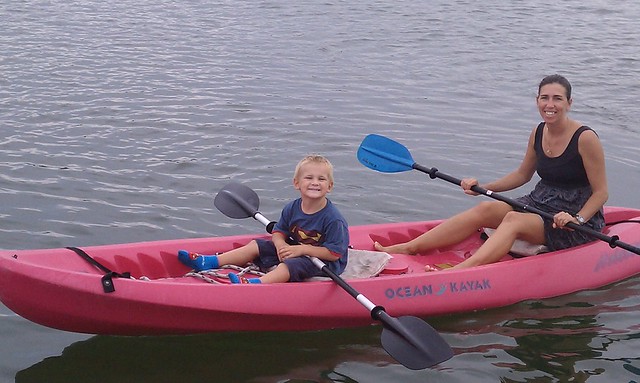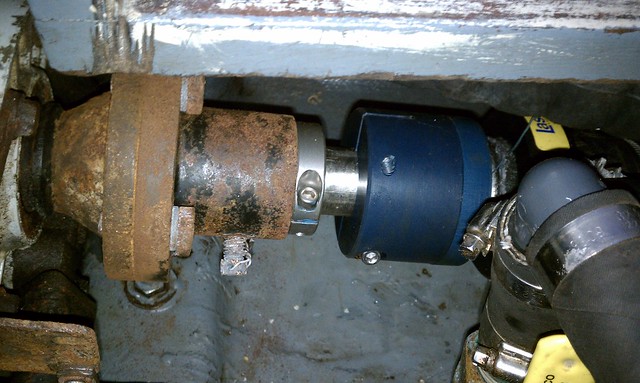The saga of our Mercury 25 2-stroke is nearing an end. Unfortunately it doesn’t look like it is going to be asuccessful one, at least from the perspective of that motor’s continued serviceto us. This will be a multi-part post;first to discuss the problems we continue to have with the Mercury, and then towalk through our options and thought processes as we begin to consider a new motor. By the end of next week we should have a final decision up or down on the Merc.
[more]
There were warning signs from the beginning; we just didn’tknow enough to see them. When we boughtthe motor, the skeg was damaged and it had a new prop. The owner told us he had hit a rock and thedriveshaft had also broken and been replaced.
There was also salt buildup around the cylinder heads from a coolingwater leak.
We used the motor daily for 6 months without so much as ahiccup. It started immediately on thefirst pull or first touch of the button.
It ran smooth and never gave us any trouble. It idled evenly, though perhaps a touch fast,and it smoked a little, but not abnormal for a 2-stroke. It was plenty fast; pushing our 12 foot RIBat 29mph. The power tilt was a boon forTanya and she was the envy of other women struggling with big motors.
But after awhile we could no longer ignore little drops ofoil we saw leaking from the lower unit when the boat was lifted out of thewater. And we noticed lots of oil aroundthe inside of the lower cowling.
We thought the oil from the lower unit was a bad rear oilseal on the gearcase, and pulled the motor to work on that. In retrospect, the length of time that weobserved oil without the gears seizing and the presence of oil up top shouldhave led us in a different direction.
Sure enough, the gearcase was full and had no water in it, so the sealwas fine. But during the course ofchecking it, we discovered that the prop shaft was twisted and the thrust hubdid not want to come off. We alsolearned that the exhaust body had lots of oil and tar-like buildup inside it.
It was also during this initial project that we removed andcleaned our perfectly running carburetor (or so we thought). That was dumb and it took a good bit oftweaking and tuning to get it running again, and it never ran as well as before,with misfires and fouled plugs in the #1 cylinder. At this point the salt around the headreturned to our consciousness and became a likely factor.
This is the stage we were at when we began to think that anew motor was justified; faced with the twisted shaft, the mysterious oil, andthe wet cylinder heads. But weconsidered it a learning opportunity and told ourselves that “the motor we knowis better than one we don’t”. So wehauled it again, took it completely apart, and inventoried the parts thatneeded replacing. The parts list topped$700 (at Internet prices), plus the powerhead needed a $300 trip to the machineshop to rethread some broken head bolts.
In the lower unit we replaced the prop shaft, thrust hub,bearing, bearing carrier, and rear oil seal.
The oil seal itself was fine, but the bearing carrier was broken,probably from the same impact that did the other damage. We were operating under the philosophy ofreplacing everything that wasn’t right, whether it was actually detrimental ornot. The water pump received a newimpeller and new gaskets.
We discovered a broken exhaust tube between the powerheadand the lower unit, which explained the strange rattling noise from that partof the motor. It also had an amazingamount of exhaust buildup. We weren’tsure exactly how the exhaust tube was supposed to be attached, so rather thantry to fix it we just replaced it, which entailed a new adapter plate under thepower head.
Removing the head bolts was a serious exercise infrustration. Aluminum block + stainlessbolts + salt water = corrosion. Thebolts really, really should have been treated to prevent them from freezinginto the block and then breaking when we tried to remove them. It turned out that this motor doesn’t reallyhave a head, just a cover for the water jacket.
The cylinders are sealed except for the spark plug holes. So the salt buildup (and leak it indicated)was relatively innocuous except to the bolts holding the cover on. Like the carburetor, we would have been much betteroff to just leave it alone.
The powerhead was removed because we wanted to inspect thelower seal. The impact and brokendriveshaft were factoring heavily at this point. This necessitated removing just abouteverything from the powerhead. All the electronics,the throttle controls, and flywheel came off.
It was a good thing we took pictures during the disassembly because itwas a lot of little parts and wires.
Through the course of removing the electronics, wediscovered a bad coil on the #1 cylinder. This was an excellent explanation for thesource of the misfire, and possibly for the oil, too. We subsequently discovered that the lowerseal was fine, but the exhaust manifold was full of oil. This hurt, because we could have figured thatout without taking the whole thing apart if we’d only thought to look.
Now the problem simply looked like incompletecombustion. The leftover oil was oozingout of the block through the exhaust, down the body, and out of the lowerunit. The oil in the lower cowling underthe powerhead was leaking past a failed gasket on the exhaust manifold.
With the problem presumably solved and all the parts wecould find to replace replaced, we began reassembly. Miraculously, there were no “extra” partsleft over and after a few initial problems, it even ran. But it ran like shit. And that’s about the way it has been eversince.
We have rebuilt the carburetor multiple times. We have fiddled with the bowl float level. We have checked the timing. We have tested the spark with the mostreliable (and painful) method we knew.
We’ve gone through multiple sets of plugs and played with the gaps.
We’ve endlessly adjusted the idle speed and thelow speed air mix. At times we thoughtwe had it, but then after a high speed run it would fail to idle at all.
We are completely baffled.
Configured to the specifications in the shop repair manual, the motorruns so rich it pours smoke and little droplets of oil are suspended in thewater. When completely closing the lowspeed air mix screw, the motor continues to run, and idle speed actuallyincreases when the motor is supposed to die.
This seems to indicate some type of leak or malfunction inside thecarburetor.
Carburetors are magical devices. Their job is to mix atomized fuel into amotors air intake, and maintain the proper mix at all engine speeds. It took us awhile to comprehend how this actuallyhappens, and then we were amazed that somebody thought of it, and then justshocked that they could make it work.
There aren’t very many adjustments available, and those are rather crudeconsidering the precision of the carburetor’s function. So when faced with a carburetor that isn’tacting normally, there is really only one option we can think of: replace it.
So that’s it. Thecarburetor was probably off the entire time and the previous owner (or hismechanic) managed to make it run smoothly, but it was probably running way toorich even then. The only choice we feelwe have with this motor at this point is to throw more money at it in alast-ditch effort to make it right. Ifit doesn’t work, and we don’t have a lot of confidence that it will, we’ll ditchit and get a brand new motor.
During the course of the repair we’ll have spent about asmuch again as we paid for it to begin with.
And if our time is factored in, it would have been more economical tosimply buy a new motor each time. Youread that right; we could have two brand new motors for what we’ve spent onthis used one. That’s the hidden cost ofbuying used gear.
In the meantime, there is a toolbox in the dinghy at alltimes and Tanya won’t drive it by herself.


